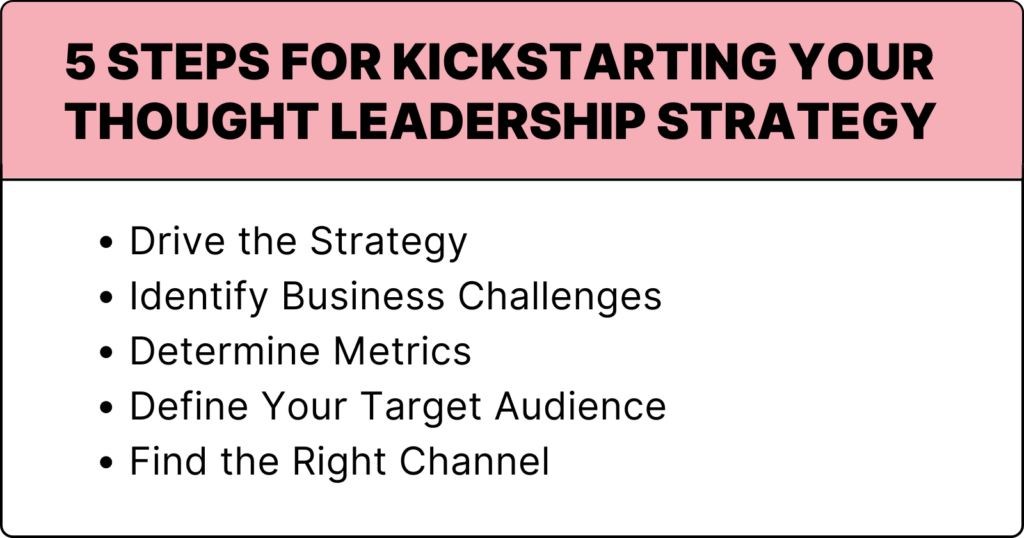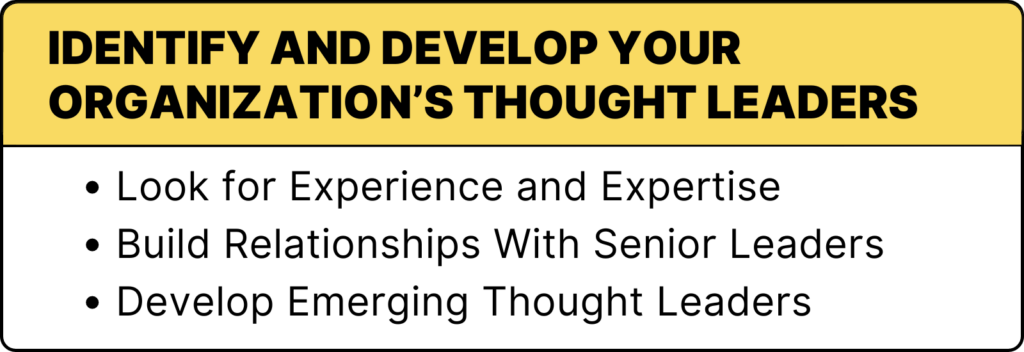Thought leadership may be a cliché, but that doesn’t mean it’s not real. In a world full of random opinions, AI regurgitation and endless self-promotion, consumers and B2B buyers alike are desperately seeking something different, original and provocative.
Recent research from Bynder underscores this need for authenticity: 26% of consumers feel a brand is impersonal if website copy seems AI-generated, and 20% consider the brand lazy. Social media content fares no better, with 25% perceiving brands as impersonal and 20% as untrustworthy when copy appears to be generated by AI. These perceptions highlight the critical role of genuine thought leadership in standing out from the crowd and building trust with your audience.
These findings illustrate the importance of human-centered content that feels authentic and trustworthy, setting the stage for thought leadership to make a real impact. But crafting a killer thought leadership strategy requires more than just avoiding AI-generated content: It’s about creating a unique point of view that resonates with your audience.
And that’s easier said than done. Read on to learn how expert marketers define thought leadership and how to position your brand as a trusted authority in your industry.

What Is Thought Leadership?
Thought leadership is the demonstration of expertise and innovative ideas aimed at influencing others. It goes beyond simply sharing knowledge to challenge the status quo and inspire change.
- Thought leadership is built on original or creative ideas. At its core, thought leadership begins with ideas that are fresh, insightful or offer a unique take on existing concepts. Whether it’s a new system, a reinterpretation of the norm or a challenge to popular opinions, these ideas help you stand out as a leader in your field.
- It involves having a clear point of view (POV) to influence others. A strong POV is essential for thought leadership. It’s not enough to present information neutrally — you need a perspective that sparks interest, debate or change. Your POV helps differentiate your ideas and positions you as capable of shaping opinions and inspiring action.
- Thought leaders demonstrate expertise via their experiences, research, or inventions. Thought leadership is grounded in credibility. Whether drawing from years of professional experience, academic research or innovations, your authority comes from backing up your ideas with evidence of your expertise, helping others trust your insights.
- The goal is to communicate ideas in a way that motivates action. Thought leadership goes beyond sharing knowledge — the ultimate goal is to drive change. Whether you aim to shift perspectives, challenge behaviors or inspire new ways of thinking, thought leadership involves influencing your audience to take action based on your insights.
- Thought leadership can be expressed through blog posts, social media, public speaking, and more. Once you’ve developed your ideas and expertise, the next step is sharing them effectively. There are countless platforms to express thought leadership, including writing blog posts, creating social media content, speaking at conferences or producing videos. The key is choosing the best medium for your audience.
- Successful thought leadership connects with a selective audience, seeking to change their thinking or behavior. Effective thought leadership isn’t about reaching everyone — it’s about targeting the right audience. By focusing on a group of individuals who are open to your message and motivated to act, you increase your chances of making a lasting impact.
- Anyone in an organization, regardless of title, can become a thought leader. Thought leadership is not limited to executives or those with formal authority. Anyone with expertise and a strong perspective can become a thought leader, whether they are at the top of the organizational chart or just starting. The key is demonstrating credibility, communicating effectively and inspiring change.
Why Does Thought Leadership Matter?
Your brand’s thought leadership strategy is more important than ever.
Why? Because it works: 75% of decision-makers researched new products or services after encountering thought leadership, according to an Edelman-LinkedIn survey. Notably, 70% of C-suite execs say they’ve reconsidered vendor relationships because of thought leadership content. There’s tremendous opportunity for brands with expertise and a point of view and significant risk for those who don’t.
Thought leadership helps you scale your influence with people you want to do business with — and the people in their networks. “Thought leadership is successful when you can get people to take your ideas and carry them forward to their communities,” says Denise Brosseau, thought leadership consultant and CEO at the Thought Leadership Lab.
By investing in a strong thought leadership strategy, you position your brand as a trusted authority that influences key decision-makers and expands your reach organically. When your ideas resonate and are shared within networks, your expertise gains momentum, amplifying your impact far beyond initial interactions.

5 Steps for Kickstarting Your Thought Leadership Strategy
While ideas are foundational to thought leadership, they’re only one piece of the puzzle, especially for B2B marketing teams.
“To produce thought leadership pieces that generate business,” says Erik Samdahl, vice president of marketing at the Institute for Corporate Productivity (i4cp). “it takes proper coordination between marketing, sales and product teams to determine where demand is and what will at once provide value to the reader while also leading the reader back to the source: your company.”
To do that, you need a defined strategy and a framework for moving those ideas forward.
Drive the Strategy
To develop a thought leadership strategy that actually drives business results, you and your B2B marketing team must assert your expertise. Your thought leadership can’t produce business outcomes if you’re just there to passively publish items sent to you from other parts of the business.
“In some firms, there is a tendency for the marketing department to be viewed as a support or service center,” says Subarna Ganguly Marshall, global editor-in-chief at Zendesk. But there’s no strategy in that.
What products, platforms or solutions are business leaders preparing to launch? What problems will those items solve? You must know the direction the business is taking before you can develop a way to help get there. To help, sit with the business and leadership teams, and work with them to envision the future.
“We can, right from its inception, visualize thought leadership aligned with the business and sales strategy,” Subarna says. “That’s where it starts: from there, we work out a thought leadership strategy.”
Identify Business Challenges
You can’t develop a strategy without goals. To tailor your thought leadership strategy, you must identify your business’s challenges. “First you need to determine what exactly you want to accomplish,” Erik says. “Presumably, you want a strategy to generate leads, publicity and, ultimately, business.”
Once you’ve identified the challenges you want to solve, align your thought leadership content to address them. If your business objective is to improve brand visibility, for instance, you can apply thought leadership by pinpointing audience pain points and industry trends. Create high-value, shareable content distributed across multiple channels, such as in-depth articles and videos. Engage your community through webinars and collaborations with industry influencers, and measure your impact to refine your strategy.
Determine Metrics
Measuring the impact of thought leadership can be challenging, but there are key metrics you can track to gauge the effectiveness of your strategy. Start by identifying your primary goals — are you aiming to grow your audience, increase website traffic, or enhance brand awareness? The goal behind thought leadership isn’t just to drive sales or lead generation. “You want to increase your brand positioning, enhance your market visibility, improve loyalty to your brand, and bring a follower base to your social media pages,” Subarna says.
Set concrete metrics at the beginning of your development process. “I always start with the end in mind,” Denise says. “What are you measuring that success by? What are the metrics you’re using?” Determining objectives and key results (OKRs) and key performance indicators (KPIs) on the front end allows you to work backward to develop your roadmap for achieving them.
It’s important to acknowledge that some aspects of thought leadership may not be easily measurable. For instance, while a representative of your organization speaking at a conference may not result in direct website traffic, the influence they exert could lead to long-term business relationships or increased credibility in your industry.
Thought leadership often shapes perceptions and builds trust, which can be difficult to quantify in traditional metrics. However, even if certain efforts don’t immediately show up in your data, they still contribute to your organization’s overall reputation and positioning in the market.
The key is to balance quantifiable metrics with a broader understanding of your long-term goals. While you can track engagement, web traffic and conversions, keep in mind that thought leadership is also about building credibility and trust, which may not always be immediately visible in the numbers. Over time, as your thought leadership presence grows, these efforts will contribute to your organization’s authority and influence within your industry.
Define Your Target Audience
Of course, it’s impossible to develop content without identifying the target audience. For B2B content marketing strategy, especially, thought leadership content should appeal to upper-level decision-makers at your target organizations.
Effective thought leadership campaigns also build trust and share big ideas. Don’t just think about your audience demographically, Denise says. Find out: What does your target audience believe today? What are you trying to move them towards or away from?
Think about how to engage your audience in a conversation. For example, if you’re wondering how to build thought leadership on LinkedIn, you can’t just blast links at people (and not just because the algorithm penalizes that nowadays). It’s about bringing forward an idea, and articulating the change you want to see in the world, Denise says.
And since the goal is to engage your audience, you have to understand how they consume content and participate in the larger conversations your thought leadership inspires.
That’s why producing approachable content is so important. Make sure you’re creating relevant, readable, and relatable content that still speaks to your target audience’s familiarity and needs.
“You can do that by striking that delicate balance between ensuring that your content speaks to the right audience with the right level of expertise,” Subarna says, “but at the same time is bereft of any technical jargon and is told in a story that makes sense to anyone who reads it.”
Find the Right Channel
Determining the right medium or channel for your thought leadership strategy begins with understanding both your audience and the strengths of your thought leaders. Consider where your target audience spends their time and how they prefer to consume content. For example, if your audience frequently reads industry blogs or newsletters, long-form articles or guest posts may be the most effective way to establish your thought leader’s authority. On the other hand, if your audience is more active on social media, concise, high-impact video posts or engaging LinkedIn articles might be a better fit.
It’s also important to consider the strengths of your thought leaders. Not every thought leader will excel in every medium, and that’s okay. Some may be dynamic public speakers who can influence through speaking engagements and podcasts, while others might thrive in writing or creating in-depth reports. A balanced thought leadership strategy incorporates a mix of content types — blogs, videos, podcasts, social posts — but not every leader needs to use all mediums at once. Tailoring the content format to each individual’s strengths ensures that the message is both authentic and meaningful.
Finally, start small and scale up. Test which channels resonate most with your audience and adjust your approach accordingly. Thought leadership is about delivering value where it will be best received, so being flexible with your content strategy will help you achieve the greatest impact over time.
With these foundational steps in place, you’re now ready to focus on cultivating thought leaders within your organization who can champion and advance your thought leadership efforts.

Develop Your Organization’s Thought Leaders
An important piece of developing a B2B thought leadership strategy is assessing the expertise you have access to within your organization. Start by defining your company’s thought leaders.
Look for Experience and Expertise
Thought leaders are typically (though not always) senior leaders. “Some ‘thought leaders’ in your organization are self-apparent,” Erik says. “They’ll be an executive, a functional leader or simply a smart, charismatic individual contributor.”
To identify thought leaders within your organization, look for individuals who consistently generate innovative ideas and provide unique insights that align with your business goals. These individuals may be recognized for their expertise in specific areas, such as industry trends, emerging technologies, customer behavior or operational efficiency. A true thought leader not only possesses this expertise, but also communicates it in ways that resonate with your target audience, driving engagement and influencing critical decisions.
Different thought leaders bring expertise in various areas, such as product innovation, market strategy, or organizational culture. Identifying which of these areas ties directly to your business strategy is crucial.
For example, if your goal is to lead in digital transformation, a thought leader with expertise in AI or data analytics would be valuable. Their insights could shape your business approach, helping you stay ahead of industry trends while resonating with your audience’s needs and expectations. Thought leaders who align with both your business goals and your target market’s interests are essential in positioning your organization as an industry leader. As you identify potential thought leaders, consider these questions: What are their areas of expertise? What thought leadership experience, if any, do they have? Have they published anything before? Look for people with a track record of communicating their ideas through written articles or speaking engagements, like webinars or podcasts.
Build Relationships With Senior Leaders
Develop a habit of introducing yourself and your team to any new senior-level leaders joining the organization. Get to know them, their background and their experiences in their field, Subarna says.
Keeping tabs on thought leaders in your organization is about building and nurturing relationships with these experts to stay informed about their ongoing projects and insights. Regularly engage with them to understand what they’re currently working on, their latest research and their emerging ideas. This active involvement ensures you’re always up-to-date on the most relevant and cutting-edge content.
Imagine Sarah, a content strategist at a tech company, who makes it a point to regularly check in with Raj, the head of AI research. Raj is deeply immersed in developing new algorithms and often presents his findings at industry conferences.
During one conversation, Raj mentions a breakthrough he’s working on involving ethical AI, which Sarah immediately sees as valuable for the company’s thought leadership efforts. Because she’s in the loop, Sarah can collaborate with Raj to turn this research into a series of blog posts, a webinar and a podcast interview, keeping the company at the forefront of the industry.
Develop Emerging Thought Leaders
A sustainable thought leadership strategy relies not just on the expertise of current thought leaders, but also on identifying and upskilling the next generation to speak with authority.
“When it comes to finding the ‘people who are comfortable in the spotlight,’” Denise says “there is often a lot of unrecognized talent.”
First, you must identify up-and-coming experts who want to share their knowledge and perspective. “Provide a means for people to raise their hands and volunteer or for employees to recommend their peers,” Erik suggests. Having colleagues nominate each other can help you find professionals with the most charisma and, potentially, the best stories to tell.
“If we’re going to make our organization be seen as a thought leader,” Denise says, “we have to look for that talent throughout the different departments, levels and people in the organization.”
Beyond identifying these people, we need to create platforms and opportunities for them to step forward and share their ideas. Provide emerging thought leaders with low-stakes opportunities to share their thoughts. Consider inviting employees to collaborate with the marketing team to create a post for the company blog, for example, or to share their ideas in a conversational video recording session.
Up-and-coming thought leaders could gain experience by putting forward a perspective, shaping a point of view, articulating an argument, and generally being in the spotlight. This will help give them the confidence to represent the organization in a more professional capacity.
What programs or processes could you implement to train the next generation of thought leaders? “What are [you] doing to keep the bar low for people to step into these roles?” Denise asks.
Thought leadership succession planning can help your company strengthen its muscle for sharing bold ideas and increase both visibility and trust in the market.
Offer a Bold Perspective
An effective thought leadership content strategy requires bold perspectives, especially in this era where AI commodifies generic content. After you build a bench of thought leaders, you need to leverage their unique insights to show how your brand thinks and acts differently.
Build Trust With Thought Leaders
Demonstrate your expertise as a marketing professional and interviewer so you can influence your thought leaders. Subarna tells thought leaders: “You may be the [subject matter expert], but I am the marketing and thought leadership expert.” Taking a proactive leadership role helps thought leaders feel more comfortable and confident trusting their ideas with you.
When thought leaders trust you, you can better help them refine their ideas to the point where they can articulate the value they contribute to the industry. This will become their content value proposition.
Explain the Value of a Hot Take
Typically, a thought leadership piece will add to an existing conversation or use evidence and experience to disagree with a commonly held perspective. The content doesn’t have to be controversial. It does, however, have to say something new and support that position.
“If you’re going to talk about this topic in a way that’s not going to raise any eyebrows, present any new perspectives, trigger any conversations, any debate, any engagement,” Subarna tells SMEs, “then it’s probably not going to be published.”
When your content stirs debate and sparks conversations, it engages your audience and gets them thinking. Sharing hot takes and presenting new perspectives can drive innovation and encourage people to rethink their beliefs. When handled carefully, controversial topics can show your brand’s boldness and willingness to lead industry discussions. This positions you as a forward-thinking leader and builds a reputation for being at the forefront of change. Plus, it makes your content more memorable and shareable, boosting visibility and engagement.
Refine Your Thought Leaders’ Hot Takes
Encourage thought leaders to dig deep into their individual professional experiences, but keep them focused on the larger context, too. That’s where thought leadership delivers the most value. Work with thought leaders to help them pinpoint what’s different about their perspective and why sharing it is important for their industry.
Develop a process for reviewing ideas, Denise says, especially with other business leaders who can offer their own perspectives. Workshopping an idea can help a thought leader sharpen and refine it.
Create a community setting where people can share and workshop their ideas. Denise suggests looking at Vistage’s “care-frontation” practice as a model. Care-frontation is built on trust and invites participants to share ideas they haven’t fully formed. The intent is to weed out the weak ideas and strengthen the strong ones. Sharing ideas in a safe, positive environment can be empowering — especially for those with the biggest, boldest proposals.
Share Ideas Across the Organization
Thought leaders should be well-versed in their field and how their work intersects with other aspects of the business. Workshopping ideas with peers in other departments can help refine them and account for other perspectives moving forward. Gathering other perspectives can also help you ensure you aren’t publishing ideas already well-stated elsewhere.
“We have to have that step,” Denise says. Bringing thought leaders together to workshop, question and push back on ideas empowers them to take a bolder perspective — without fearing they will fall on their faces.
Take Pixar, for example. The company’s “Braintrust” is a collaborative model for sharing and refining ideas. Your marketing team can help thought leaders be bold and refine their ideas against other peoples’ perspectives.
That can have a huge impact — and not just on your marketing campaign. “Most companies don’t think this way,” Denise says. “They don’t understand the power of their ideas to influence their industries.”
Develop a Process for Turning Ideas Into Content
Now that you have their ideas, it’s time to execute your thought leadership content strategy with the help of defined, repeatable processes.
The tactical process of thought leadership content creation differs by company, Brosseau says, but the basic steps include:
- Gathering an idea from a company expert.
- Working with the expert to reflect on, articulate and expand their idea.
- Gathering input on produced content from the expert and from their peers.
Whatever your process, it should be consistent across the company. Start with an iterative, agile approach. As you create pieces of thought leadership content, spend time debriefing. This can help you distill a toolkit, methodology or repeatable framework.
You should also make a database of the thought leaders at your company. Compile any thought leadership pieces they’ve already produced, whether at your company or prior to joining your organization. “It’s not easy to do,” Subarna concedes, but assembling a repository of knowledge from each thought leader beforehand helps you assess the expertise you have available within the company.
The thought leaders at your company are typically very busy people, and they may struggle to find time to sit down and write. That’s why it’s up to you to see the potential in an idea and polish it into something that will help you achieve your strategic goals. Support your thought leaders by streamlining the transmission of thought leadership content through simple means, like recorded conversations or existing written content.
Subarna says thought leadership campaigns can sometimes develop from a single slide with a few bullet points or a few paragraphs of writing in a stream of consciousness style. “The process starts with an idea or a very rough draft, and from there I usually map out the future of that piece,” she says. “I think about how we can transform that into several pieces.”
Ideas for thought leadership shouldn’t be single-use; plan to get a digital marketing campaign’s worth of mileage out of them across several types of content. “It has to have an application with different formats,” Subarna says.
Trending topics that don’t require a lot of research can make a good short article or blog post. Simply having a conversation with a thought leader often produces enough content for an article, and can be recorded to produce derivative multimedia content. You can adapt a recorded interview into a longer explainer video, for instance, or several short videos optimized for different social channels.
Position Your Brand as a Thought Leader
By combining thought leadership best practices with a keen understanding of your brand’s strengths, positioning and differentiating factors, your organization’s thought leadership can raise the bar in your industry. But to do so, you must stay engaged with the thought leaders in your organization to ensure you’re always tapping into their latest ideas and innovations.
A lasting thought leadership strategy relies on building authentic relationships, nurturing emerging insights and supporting the next generation of thought leaders to keep your brand ahead of the curve as the marketplace evolves.






